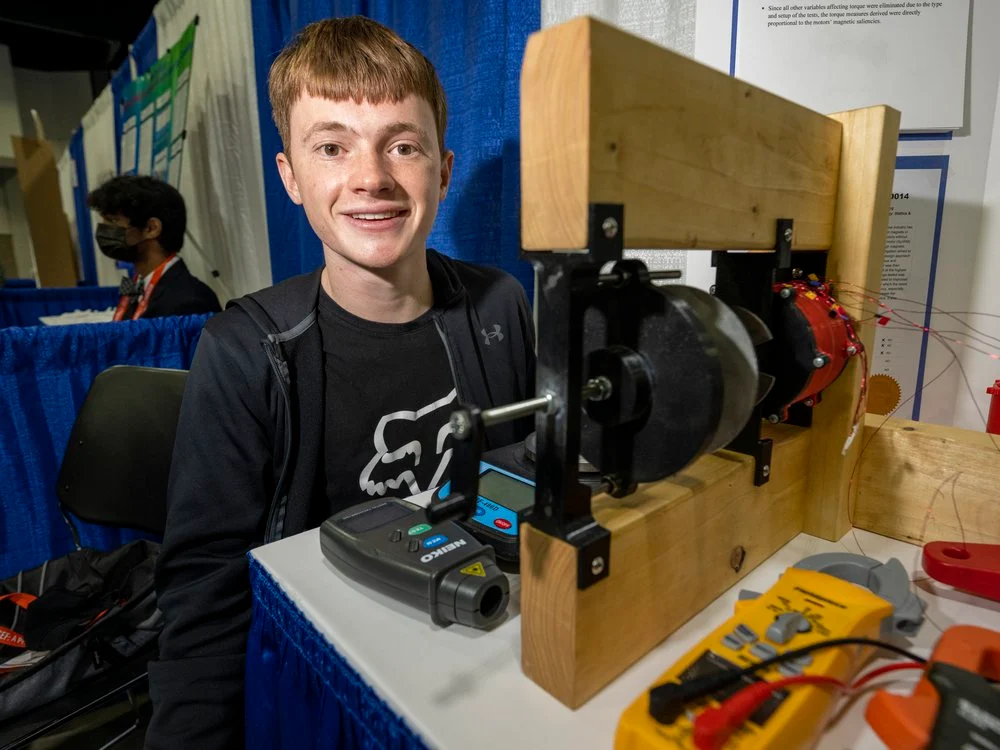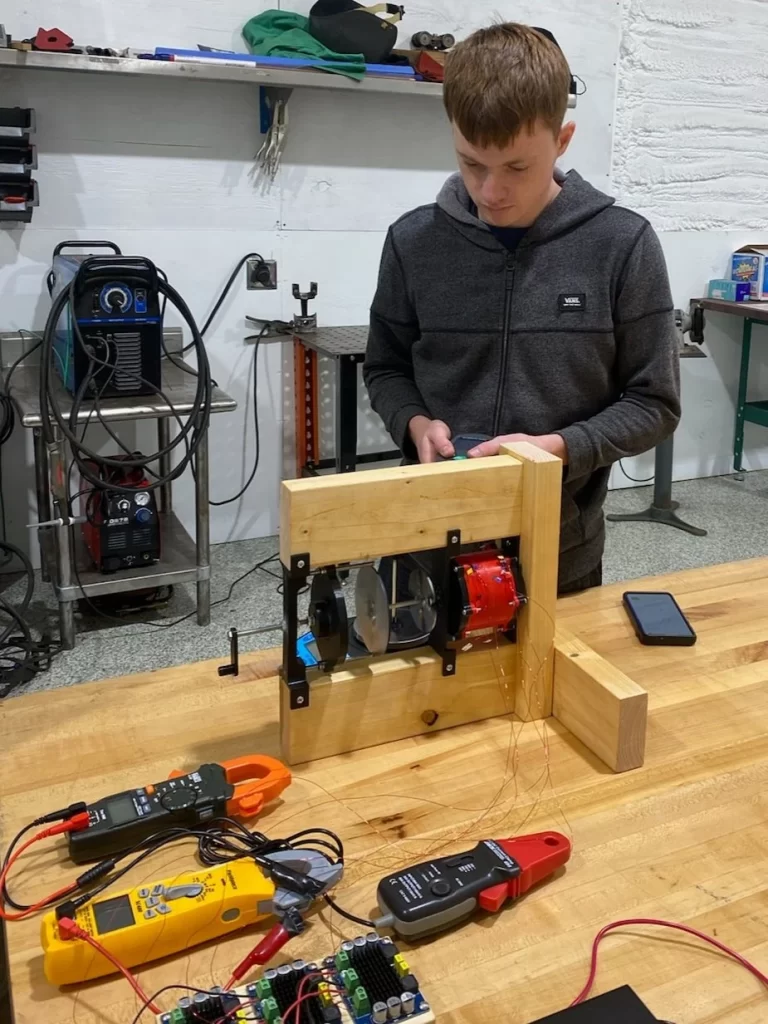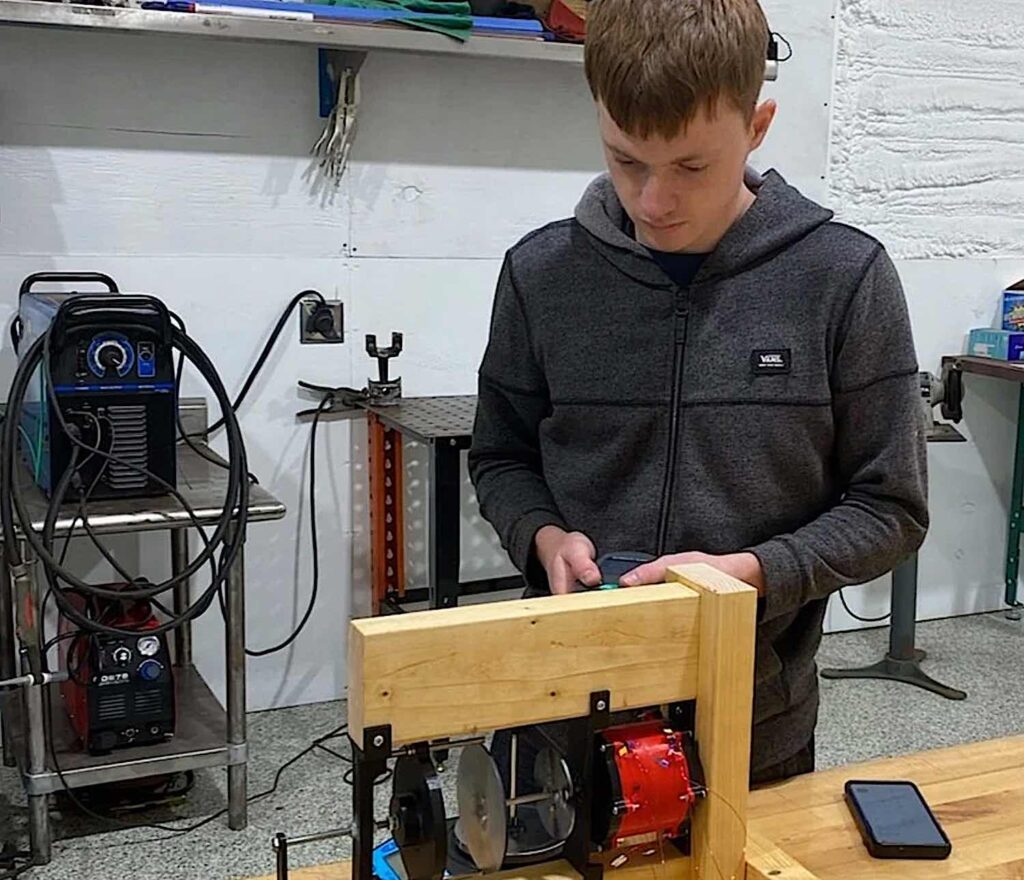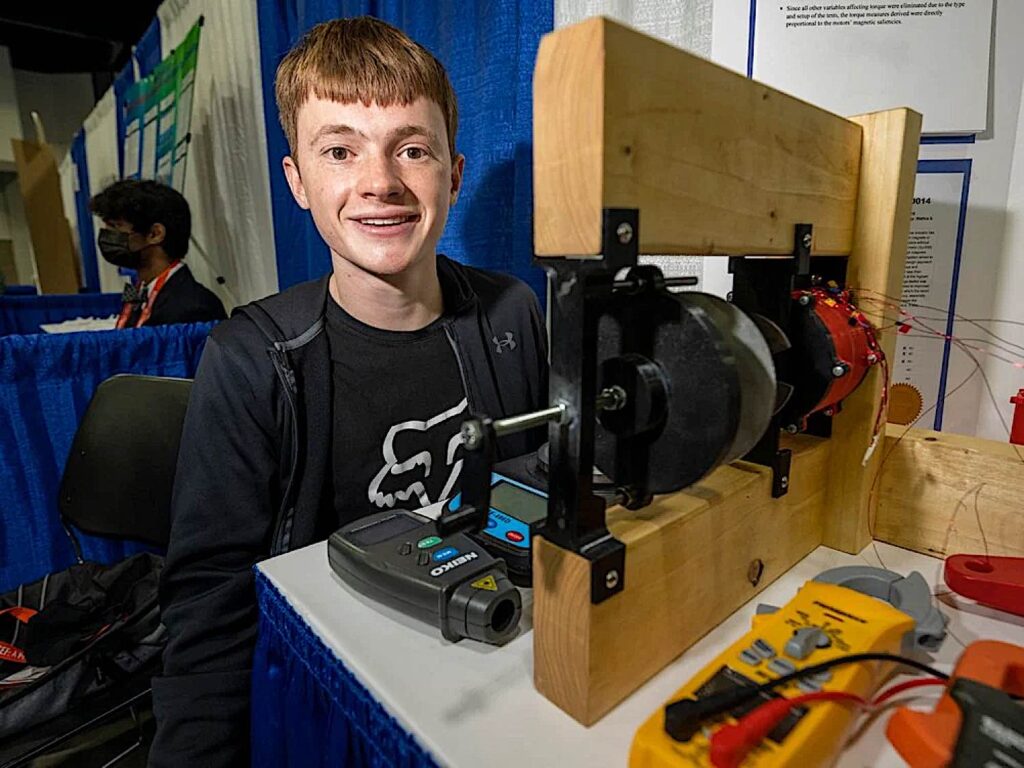This 17-Year-Old Designed a Motor That Could Potentially Transform the Electric Car Industry
Winner of the George D. Yancopoulos Innovator Award
Robert Sansone’s research could pave the way for the sustainable manufacturing of electric vehicles that do not require rare-earth magnets
Robert Sansone is a natural born engineer. From animatronic hands to high-speed running boots and a go-kart that can reach speeds of more than 70 miles per hour, the Fort Pierce, Florida-based inventor estimates he’s completed at least 60 engineering projects in his spare time. And he’s only 17 years old.
A couple years ago, Sansone came across a video about the advantages and disadvantages of electric cars. The video explained that most electric car motors require magnets made from rare-earth elements, which can be costly, both financially and environmentally, to extract. The rare-earth materials needed can cost hundreds of dollars per kilogram. In comparison, copper is worth $7.83 per kilogram.
“I have a natural interest in electric motors,” says Sansone, who had used them in different robotics projects. “With that sustainability issue, I wanted to tackle it, and try and design a different motor.”
The highschooler had heard of a type of electric motor—the synchronous reluctance motor—that doesn’t use these rare-earth materials. This kind of motor is currently used for pumps and fans, but it isn’t powerful enough by itself to be used in an electric vehicle. So, Sansone started brainstorming ways he could improve its performance.

Over the course of a year, Sansone created a prototype of a novel synchronous reluctance motor that had greater rotational force—or torque—and efficiency than existing ones. The prototype was made from 3-D printed plastic, copper wires and a steel rotor and tested using a variety of meters to measure power and a laser tachometer to determine the motor’s rotational speed. His work earned him first prize, and $75,000 in winnings, at this year’s Regeneron International Science and Engineering Fair (ISEF), the largest international high school STEM competition.
The less sustainable permanent magnet motors use materials such as neodymium, samarium and dysprosium, which are in high demand because they’re used in many different products, including headphones and earbuds, explains Heath Hofmann, a professor of electrical and computer engineering at the University of Michigan. Hofmann has worked extensively on electric vehicles, including consulting with Tesla to develop the control algorithms for its propulsion drive.
“The number of applications that use magnets just seems to be getting larger and larger,” he says. “A lot of the materials are mined in China, and so the price can often depend upon our trade status with China.” Hofmann adds that Tesla recently started using permanent magnets in its motors.
Electric motors use rotating electromagnetic fields to spin a rotor. Coils of wire in the stationary outer portion of the motor, called the stator, produce these electromagnetic fields. In permanent magnet motors, magnets attached to the edge of a spinning rotor produce a magnetic field that is attracted to the opposite poles on the spinning field. This attraction spins the rotor.
Synchronous reluctance motors don’t use magnets. Instead, a steel rotor with air gaps cut into it aligns itself with the rotating magnetic field. Reluctance, or the magnetism of a material, is key to this process. As the rotor spins along with the rotating magnetic field, torque is produced. More torque is produced when the saliency ratio, or difference in magnetism between materials (in this case, the steel and the non-magnetic air gaps), is greater.
Instead of using air gaps, Sansone thought he could incorporate another magnetic field into a motor. This would increase this saliency ratio and, in turn, produce more torque. His design has other components, but he can’t disclose any more details because he hopes to patent the technology in the future.
“Once I had this initial idea, then I had to do some prototyping to try and see if that design would actually work,” Sansone says. “I don’t have tons of resources for making very advanced motors, and so I had to make a smaller version—a scale model—using a 3-D printer.”

Report: 17 year old student invents innovative new electric motor that could transform the EV industry
Not all innovations in the field of electric vehicles come from major automakers or Silicon Valley tech companies. Sometimes, it’s the work of bright young minds that leads the way to a more sustainable future.
One of those young minds belongs to 17-year-old inventor Robert Sansone from Fort Pierce, Florida, who has created a new type of electric motor that could revolutionize the EV industry.
Sansone is no stranger to innovation. A passionate budding engineer from a young age, he estimates that he has completed over 60 engineering projects in his spare time.
From high-speed running boots to a go-kart capable of reaching speeds of over 70 miles per hour and animatronic hands, this promising young scientist has never been afraid to take on a challenge.
Now, Sansone has turned his attention to solving a problem that has long plagued electric vehicles: the unsustainable components used when manufacturing a vehicle designed to drive sustainability.
As Sansone says, “Seeing the day when EVs are fully sustainable due to the help of my novel motor design would be a dream come true.”

The inspiration behind the research
The seed for Sansone’s research was planted a couple of years ago when he came across a video outlining EVs’ pros and cons.
In the video, he saw that while electric vehicles don’t produce emissions and are much better for the environment than petrol or diesel cars, most electric car motors rely on magnets to function.
These magnets are usually made from rare-earth materials, and that’s where the issue lies.
These rare-earth elements are not only costly to extract and expensive to buy, with a price tag of hundreds of dollars per kilogram, but they’re also not renewable and environmentally harmful to process.
Rare-earth elements include metals like neodymium and dysprosium, typically dispersed in the environment in very low concentrations and not found in large, economically extractable deposits. This is what makes them difficult and expensive to mine and refine. Most of the world’s supply of rare-earth elements is found in just a few countries, including China, which currently dominates the market.
With the high demand for these materials, not only for the EV industry but also in the manufacturing of consumer electronics, solar panels, and wind turbines, the industries that rely on them are at the mercy of China’s supply and pricing.
It’s not just a cost problem. The environmental impact of rare-earth mining and refining is also a major concern. The process often uses harmful chemicals and generates a great deal of toxic or even radioactive waste. This waste can end up in the groundwater and soil, contaminating both the land and water around the mines. [2]
After seeing the video, Sansone was determined to find a way to create an electric motor that didn’t rely on rare-earth materials.
Video of Robert Sansone, winning the award:
The synchronous reluctance motor
With his passion for electric motors and drive to create a more sustainable product, Sansone set out to build an electric motor that didn’t need magnets, as most EVs on the market do.
His starting point was the synchronous reluctance motor, which is already used in smaller appliances such as pumps or fans. These motors don’t use rare-earth materials, but they’re not very efficient.
Current designs for this motor didn’t have the power required to be used in an EV, and that’s the problem that Sansone set out to solve; how to improve the design to make it more powerful.
Traditional electric motors use rare-earth magnets to create a rotating magnetic field in the stator or stationary part of the motor.
This rotating field interacts with the rotor or moving part of the motor, which causes it to rotate. The rotor is what the wheels of the car are attached to, so it needs to be very strong in order to turn them at high speeds.

The magnets in the stator are what give the rotor the power it needs to rotate quickly and with a lot of force.
Synchronous reluctance motors, on the other hand, don’t use magnets. They work by using a steel rotor with air gaps cut into it that align with the windings in the stator.
When current is applied to the stator’s windings, it creates a rotating magnetic field. This field interacts with the steel rotor and causes it to rotate. Two critical measures that determine the motor’s power output are the materials’ reluctance and saliency ratio.
The reluctance of a material is the measure of how difficult it is for a magnetic field to pass through it, and the saliency ratio measures the difference in magnetism between the stator and rotor materials. A higher saliency ratio means a greater difference in the ability of the two materials to interact with a magnetic field, which results in more torque and a more powerful motor.
The question is, how can the reluctance and saliency ratio be increased to make a more powerful motor?

Sansone’s design
The premise for Sansone’s design was that if he incorporated another magnetic field into the motor instead of just relying on the air gaps, he could increase the saliency ratio and make a more powerful motor with more torque.
With this idea in mind, he set out to create a prototype for this design. Without the resources of a large corporation or research facility, he had to get creative with the materials he used.
Over the course of a year, Sansone created a scale model of his prototypes using a 3-D printer, together with a steel rotor and copper wires. And without the help of a mentor or advisor, he would spend countless hours researching to troubleshoot every problem he encountered.
After much trial and error, on the 15th motor, Sansone finally arrived at a working prototype of his design.
He tested the power of the prototype using a variety of meters and the rotational speed using a laser tachometer.

He found that his innovative design outperformed traditional synchronous reluctance motors both in terms of torque and efficiency, just as he had hoped.
These were the test results of his prototype when compared to a more traditional synchronous reluctance motor.
At 300 revolutions per minute (RPM), his design showed:
- 39% greater torque
31% greater efficiency
The efficiency increased as the speed increased, and at 750 RPM, his design was 37% more efficient than the traditional synchronous reluctance motor.
Given the limited materials he had, Sansone’s design couldn’t be tested at the speeds that an electric car would need (for example, Tesla’s Model S motor can reach speeds of up to 18,000 RPM). He found out the hard way that the plastic pieces would overheat and melt at higher RPMs.
Sansone validated his results through a second experiment that eliminated all other variables and confirmed that it was the higher saliency ratio of his design that resulted in higher torque and motor efficiency.
Heath Hofmann, a University of Michigan electrical and computer engineering professor, said that Sansone is looking at things the right way. Although he cautioned that while this design is promising, and the materials used in building synchronous reluctance motors are cheap, the problem lies in the manufacturing costs.
These machines are complex and difficult to manufacture, which right now is a limiting factor to achieving more widespread use.
Sansone hopes that with new technologies such as 3-D printing, the manufacturing process will be easier and more accessible, making his design more viable in the future.
Competition-winning design
For now, Sansone’s work has earned him recognition and praise, landing him first prize at this year’s Regeneron International Science and Engineering Fair (ISEF). Judges at this international high school STEM competition, the largest of its kind, awarded him the prize and $75,000 in winnings, which he plans to put towards his future education. He hopes to attend the Massachusetts Institute of Technology (MIT) upon graduating high school and continue his work in engineering.
Sansone hadn’t planned on entering any competitions, but with the amount of energy and passion he was putting into his research, when he learned that one of his classes allowed him to complete a year-long research project on a topic of his choice, he saw an opportunity to continue his work and see where it led him.
His work turned into a solid science fair project, doing well at district and state competitions before advancing to compete at ISEF.
What’s next for Sansone?
After winning the ISEF with his 15th prototype, Sansone is now working on calculations and 3-D modeling for his 16th prototype. He’s planning to use sturdier materials to test his design at higher speeds.
If his motor continues performing well and offering improved torque and efficiency, he hopes to patent his design. And once the technology is patented, he hopes it will become a viable design for electric car companies to consider using in the future.
Robert Sansone’s research has the potential to be a game-changer for the electric car industry by reducing the reliance on rare-earth metals, making a significant impact in the realm of renewable energy, and increasing the sustainability of these vehicles.


/https://tf-cmsv2-smithsonianmag-media.s3.amazonaws.com/accounts/headshot/MargaretOsborne.png)